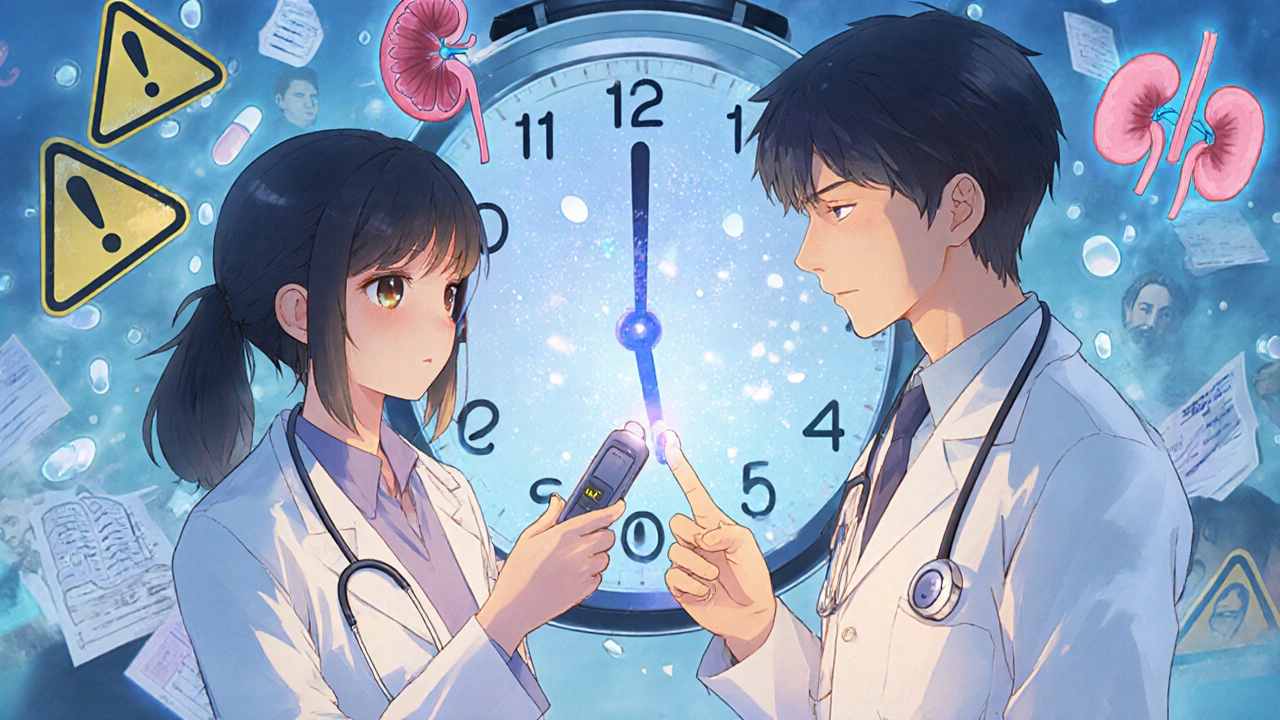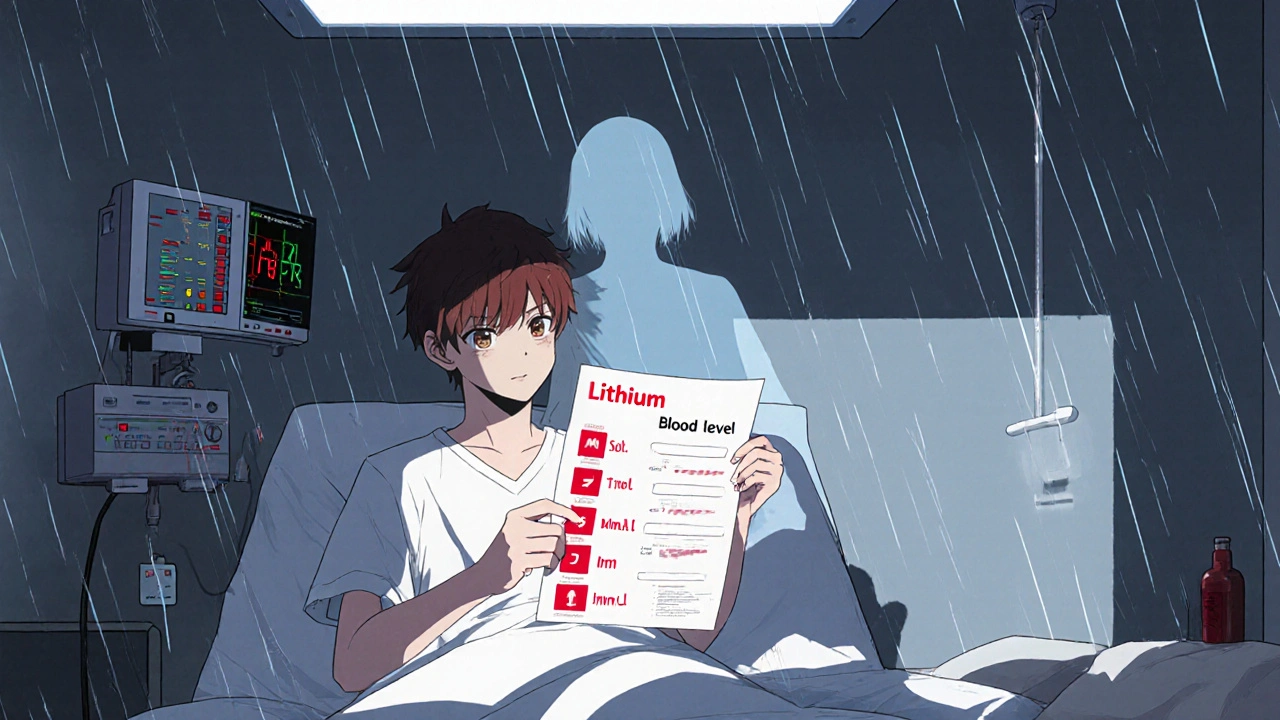Lithium Interaction Risk Calculator
Select medications you're taking with lithium
Take lithium for bipolar disorder? If you're also using a common painkiller or water pill, you could be at serious risk - even if your lithium dose hasn't changed. This isn't theoretical. People have ended up in the hospital, needed dialysis, or worse, because their lithium levels crept into the danger zone after starting an over-the-counter NSAID or a diuretic prescribed for high blood pressure. The problem isn't the lithium itself. It's how easily other drugs can mess with how your body handles it.
Why Lithium Is So Sensitive
Lithium isn't broken down by your liver. It doesn't bind to proteins. It doesn't get stored in fat. It just flows through your kidneys, filtered out of your blood, and mostly excreted in urine. That sounds simple - until you realize your kidneys are also the main place where sodium gets reabsorbed. And lithium? It tricks your kidneys into thinking it's sodium. So when sodium levels drop - like when you take certain drugs - your kidneys hold onto more lithium, too.
The safe range for lithium in your blood is tiny: 0.6 to 1.2 mmol/L. Go above 1.5 mmol/L, and you're in toxicity territory. At 2.0 mmol/L, you're likely to have confusion, tremors, and nausea. Above 2.5 mmol/L, you risk seizures, coma, or death. And here's the kicker: you might not feel anything until it's too late. That’s why monitoring isn't optional - it's life-saving.
Diuretics: The Silent Lithium Triggers
Diuretics - water pills - are one of the biggest culprits. They make you pee more to lower blood pressure or reduce swelling. But they also change how your kidneys handle sodium. And that directly affects lithium.
Thiazide diuretics like hydrochlorothiazide and bendroflumethiazide are the worst offenders. They act on a part of the kidney where lithium gets reabsorbed. Studies show they can spike lithium levels by 25% to 40%, sometimes even fourfold. One study found 75-85% of patients on lithium who started a thiazide saw their levels rise dangerously. That’s not rare - it’s expected.
Loop diuretics like furosemide are a bit safer, but still risky. They typically raise lithium by 10-25%, especially in people with existing kidney problems (eGFR below 60). The difference? Thiazides are more predictable in their effect. Furosemide is more variable, but still dangerous enough that doctors don’t recommend it unless absolutely necessary.
And here’s the trap: many people take diuretics for high blood pressure or heart failure. If you're on lithium and your doctor prescribes a new blood pressure med, they might not realize the risk. That’s why you need to speak up - and why your doctor needs to check your lithium level within 4 to 5 days of starting any diuretic.
NSAIDs: The Over-the-Counter Danger
Headache? Arthritis? Back pain? You might grab ibuprofen or naproxen without thinking twice. But if you’re on lithium, that’s a gamble. NSAIDs block prostaglandins - chemicals that help keep blood flowing to your kidneys. Less blood flow means your kidneys filter less, so lithium builds up.
The effect varies by drug. Indomethacin is the strongest, raising lithium levels by 20-40%. Piroxicam and naproxen can bump it up 15-30%. Even ibuprofen, the most common OTC painkiller, can increase levels by 15-20%. That’s enough to push someone from safe to toxic in just a few days.
And here’s the scary part: people don’t tell their doctors they’re taking OTC meds. A 72-year-old woman in New Zealand died from lithium toxicity after starting an NSAID for joint pain. Her levels went from 0.8 to 1.9 mmol/L in a week. She wasn’t monitored. She didn’t know the risk. She didn’t need to die.
Not all NSAIDs are equal. Celecoxib has the weakest effect - only 5-10% increase. If you absolutely need an NSAID, this is the one your doctor might suggest. But even then, you still need frequent lithium checks.

Other Drugs That Can Cause Trouble
It’s not just diuretics and NSAIDs. ACE inhibitors like lisinopril and ARBs like valsartan - common blood pressure drugs - also reduce kidney filtration. They can raise lithium levels by 15-25%. Calcium channel blockers like amlodipine don’t increase lithium concentration, but they can worsen side effects like tremors and ringing in the ears.
Even some antidepressants - especially SSRIs like fluoxetine - can interfere with lithium clearance. And don’t assume herbal supplements are safe. There’s not enough data to say any of them are safe with lithium. Same goes for salt substitutes, low-sodium diets, or excessive sweating. All of these can lower sodium levels and trigger lithium buildup.
What to Do If You’re on Lithium
If you’re taking lithium, here’s your action plan:
- Never start a new medication - even OTC - without telling your doctor. This includes painkillers, cold meds, and herbal teas.
- Get your lithium level checked 4-5 days after starting any new drug. This isn’t a suggestion. It’s standard care.
- Know your target range. Your doctor should have a personalized target (usually 0.6-1.0 for older adults, 0.8-1.2 for younger people). Keep a copy.
- Watch for early signs of toxicity: hand tremors, frequent urination, nausea, vomiting, dizziness, muscle weakness, or slurred speech. Don’t wait for confusion or seizures.
- If you’re sick with vomiting or diarrhea, stop your lithium and call your doctor. Dehydration spikes lithium levels fast.
Some people need to reduce their lithium dose by 15-25% if they’re on a diuretic or NSAID. Your doctor might also switch you to a safer diuretic like furosemide, or a safer NSAID like celecoxib. But the key is communication - and testing.
Monitoring: The Only Way to Stay Safe
Stable on lithium? You probably get checked every 3-6 months. But when you start a new drug, that schedule changes. You need testing every 4-5 days for the first week, then weekly for the first month. After that, monthly checks until things stabilize.
And it’s not just about blood tests. Your doctor should also check your kidney function (eGFR), sodium levels, and hydration status. A simple blood test can catch a problem before you feel sick.
There’s new tech helping too. In 2023, the FDA approved a home-monitoring device called LithoLink™ that lets you test your lithium level with a finger-prick and send results directly to your clinic. It’s not everywhere yet, but it’s a step toward better safety.

What Happens If Toxicity Occurs?
If your lithium level hits 2.5 mmol/L or higher - especially with confusion, seizures, or irregular heartbeat - you need emergency care. Standard treatment is stopping lithium and giving fluids. But here’s the catch: lithium doesn’t just sit in your blood. It gets inside your brain and other cells. Even when blood levels drop, your cells can still be overloaded.
In severe cases, doctors use hemodialysis - a machine that filters your blood - to remove lithium quickly. One case report showed a patient needed multiple dialysis sessions because lithium kept leaking back into the bloodstream from cells. That’s why you can’t just rely on a single blood test after treatment.
Why Lithium Still Matters
Lithium is the only mood stabilizer proven to reduce suicide risk by 44% compared to placebo. That’s huge. For many people, it’s the only thing that keeps them alive. But its power comes with a price: extreme sensitivity to other drugs.
The answer isn’t to stop lithium. The answer is to treat it like a precision tool - not a general pill. You need to know what’s in your body, when you took it, and how it might interact. Your life depends on it.
Can I take ibuprofen if I’m on lithium?
It’s not recommended. Ibuprofen can raise lithium levels by 15-20%, which may push you into toxic range. If you need pain relief, talk to your doctor first. They might suggest acetaminophen (paracetamol) instead, or switch you to celecoxib - an NSAID with a weaker interaction. Never take ibuprofen without checking your lithium level within 4-5 days.
What are the first signs of lithium toxicity?
Early signs include hand tremors, increased urination, mild nausea, dizziness, or muscle weakness. These can be subtle and easily mistaken for side effects of lithium itself. But if you’ve recently started a new medication - especially a diuretic or NSAID - these symptoms could mean your lithium level is rising. Don’t wait for vomiting, confusion, or seizures. Call your doctor right away.
How often should lithium levels be checked?
For stable patients, every 3-6 months is standard. But when you start a new drug like a diuretic or NSAID, check every 4-5 days for the first week, then weekly for the first month. After that, monthly checks until stable. If you’re over 65 or have kidney issues, your doctor may recommend more frequent testing.
Are there safer diuretics than thiazides for lithium patients?
Yes. Loop diuretics like furosemide are generally safer than thiazides. They raise lithium levels less - usually 10-25% versus 25-40% with thiazides. But they’re still risky, especially if you have kidney problems. Your doctor might choose furosemide only if you need a diuretic and can’t avoid it. Never switch diuretics without monitoring lithium levels.
Can herbal supplements interact with lithium?
There’s not enough research to say any herbal supplement is safe with lithium. Some, like St. John’s Wort, may affect kidney function or alter lithium levels. Others, like licorice root, can lower potassium and sodium - which can trigger lithium buildup. Always tell your doctor about any herbs, vitamins, or supplements you take - even if you think they’re harmless.
What should I do if I accidentally take an NSAID while on lithium?
Stop taking the NSAID immediately. Call your doctor or pharmacist. Don’t wait for symptoms. Get a lithium blood test within 24-48 hours. If you feel unwell - shaky, nauseous, confused - go to the emergency room. Lithium toxicity can worsen quickly, especially if you’re dehydrated or have kidney issues.
Bottom Line
Lithium saves lives. But it’s not a medication you can take on autopilot. Every time you start a new drug - even a simple painkiller - you’re changing how your body handles it. The risk isn’t small. It’s real, predictable, and preventable. The only way to stay safe is to know your numbers, ask questions, and never assume a drug is harmless. Your lithium level isn’t just a lab result. It’s your safety line.


Comments
Cecily Bogsprocket
I’ve been on lithium for 12 years, and this post saved my life. I started taking ibuprofen for a migraine last winter and didn’t think twice-until I woke up with my hands shaking like I’d had five espressos. My doctor didn’t even ask about OTC meds. I wish I’d known this before I nearly ended up in the ER. Now I keep a printed list of every drug I take, and I show it to every new provider. It’s not paranoia-it’s survival.
People think mental health meds are just pills. They don’t see the invisible math behind them. Lithium isn’t like antidepressants. It’s a scalpel. One wrong move, and it cuts deeper than you meant to.
I’m not scared of lithium. I’m scared of the silence around it. The way doctors assume you know the risks. The way pharmacies don’t warn you. The way we normalize ‘just taking something quick’ without asking if it’ll kill you.
Thank you for saying this out loud.
On November 26, 2025 AT 17:50